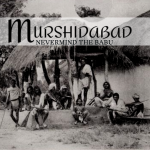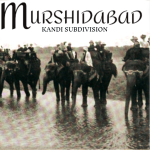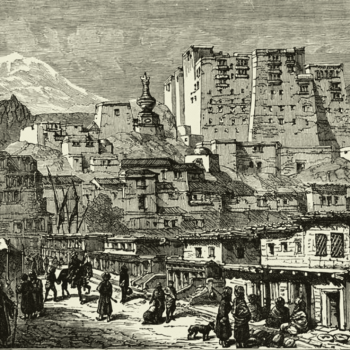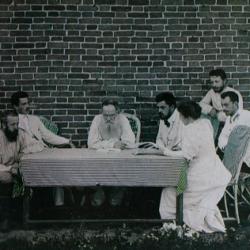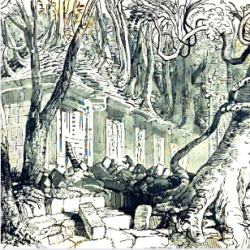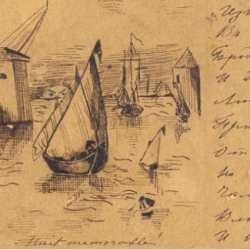POET OF THE EMPIRE
Rudyard Kipling (1865-1936,) the Anglo-Indian writer who was born in Bombay, India, features often in Johnston’s writings. As Johnston would state, “Kipling’s Indian stories […] were written in the period we are considering.”[1] Kipling’s famous refrain, in fact, “East is East and West is West, and never the twain shall meet,” was published in The Ballad of East and West in 1889.[2] Kipling’s story 1888 story, “The Sending Of Dana Da,” (re-published in 1889 in In Black And White,) would make an explicit reference to Theosophy.[3] A worthy candidate to that corpus of literature that discussed “mysticism, occultism, and theosophy [that appeared] in fiction since the publication of Marion Crawford’s Mr. Isaacs [, such as] Marie Corelli’s The Romance of Two Worlds, [and Rider Haggard’s] King Solomon’s Mines, and She.”[4] Johnston was evidently an admirer of Kipling, writing two essays about the man, “Rudyard Kipling,” and “The Paganism Of Kipling,” in 1899 and 1901 respectively.[5] (Johnston would even lecture on Kipling some twenty years after leaving India.)[6] In describing Kipling, Johnston writes: “Rudyard Kipling’s success is chiefly due to two things; intensity and movement. If we think of his work as a whole, we pay immediate tribute to his intensity.”[7]
Johnston’s first reference to Kipling occurs in “The Reincarnation Of Maung Hkin,” in which he writes: “I drove back through the dust and the sunshine from the junction, there was no ‘Burma girl a-waiting’ in his case!”[8] The line was a reference to Rudyard Kipling’s poem, “Mandalay,” written and published in 1890, and re-printed in The Barrack-Room Ballads (1892.)[9]
The theme of The Barrack-Room Ballads, written in the vernacular, was the experiences of the colonial army of the British Raj. The work tapped into a certain zeitgeist; five months after Johnston’s encounter with Maung Hkin, Sir William Moore would take up the topic of intermarriage in the pages of The Asiatic Quarterly Review. The falling value of silver made effected the purse of the Covenanted Servants in India, and the prospect of marrying an Englishwoman seemed less realistic. Moore hypothesized that in the future, the Indian Civilian was likely to marry a native wife.[10] The subject of intermarriage was becoming less taboo, in this context at least, especially marriage between Burmese women and British men, many of the latter having developed a fondness for their beauty. “Is it a sin to say that I like the Burmese maiden?” wrote one Englishman, “The Burmese woman is petite and though at first her features seem strange and are not attractive you soon get used to them and in a month, you think how pretty they are and how unpretty are those of an Englishwoman.”[11] The concept of the “temporary wives in Burma,” was already an accepted reality, and the Lieutenant Governors were aware of the “force of such attachments.” It would become such an issue, that British administrators wished that” Englishwomen [could] more freely go out to Burma, to guard the rising generation of officials from [those] dangerous connections.”[12]

Rudyard Kipling (right) & John Lockwood Kipling (left,) c. 1890. (Source: Wiki)
In “Okhoy Babu’s Adventure,” Johnston makes reference to Kipling’s “My Own True Ghost Story,” from The Phantom Rickshaw (1888.)[13] In “Kandi Subdivision,” Johnston also references the song “The Long Indian Day.”[14] The “Long Indian Day,” was a popular parody of the German song, “The Long, Long, Weary Day.” It was penned by the anonymous “Mario,” and published by Rose of Bombay in 1889, just after the Johnstons arrived in India. (The lyrics were: “Thus on from day to day, Wags the long Indian day. Until grown old and grey, We get one pound a day, And totter home to die in England. A worthy recompense, For loss of health and sense. Thus ends my story, Of soldier’s glory.”) It was referenced in Kipling’s 1890 story, “The Courting of Dinah Shadd.”[15]
Kipling grew up during the advent of the Theosophical, both in the West and in the East. During his early years at an English boarding school (1878–1882) he was introduced to Buddhism, and Edwin Arnold’s The Light Of Asia. Kipling states that “most of the young ladies of his acquaintance in London had deserted the churches and preferred to burn incense and joss-sticks in their boudoirs before little shrines containing an image of the Buddha.” In October 1882, sixteen year old Kipling returned to India, and became involved with the local Museum at Lahore, where his father, John Lockwood Kipling, was curator. “The incessant come and go of travelers, savants, specialists, etc. on their way through India,” writes Kipling, “would stay for a time in my father’s house […] where, in the sympathetic atmosphere they naturally talked at ease, and I, at the foot of the table, listened and absorbed.”[16] Kipling would work as a journalist in India during a time which overlapped with Blavatsky’s time there. In his memoirs, Kipling writes:
At one time our little world was full of the aftermaths of Theosophy as taught by Madame Blavatsky to her devotees. My Father knew the lady and, with her, would discuss wholly secular subjects; she being, he told me, one of the most interesting and unscrupulous impostors he had ever met. This, with his experience, was a high compliment. I was not so fortunate, but came across queer, bewildered, old people, who lived in an atmosphere of “manifestations” running about their houses. But the earliest days of Theosophy devastated the Pioneer, whose Editor [Sinnett] became a devout believer, and used the paper for propaganda to an extent which got on the nerves not only of the public but of a proof-reader, who at the last moment salted an impassioned leader on the subject with, in brackets: “What do you bet this is a dand lie?” [Sinnett] was most untheosophically angry.[17]
At the end of 1888, Kipling took up his pen against the Indian National Congress in Allahabad. His embittered portrayal of the delegates, resulted in his departure from India.[18] He would write a series of letters for The Pioneer (Allahabad) describing his voyage to England, which were later collected and published as a travelogue under the title, From Sea To Sea. (Johnston’s own epistles for The Providence Journal, perhaps, owe their inspiration to Kipling’s analogous writings in The Pioneer.)[19] We might imagine that Johnston read Kipling’s account in the November 20, 1889 issue of The Pioneer, in which the “poet of the British Empire,” describes Olcott’s impact on Japan:
All the world seems ready to proffer them advice Colonel Olcott is wandering up and down the country now telling them that the Buddhist religion needs reformation, offering to reform it, and eating with ostentation rice gruel which is served to him in cups by admiring handmaidens. A wanderer from Kioto tells me that in the Chion-in, loveliest of all the temples, he saw only three days ago the Colonel mixed up with a procession of Buddhist priests, just such a procession as the one I tried vainly to describe, and “tramping about as if the whole show belonged to him.” You cannot appreciate the solemnity of this until you have seen the Colonel and the Chion-in temple. The two are built on entirely different lines, and they don’t seem to harmonize. only needs now Madame Blavatsky, cigarette in mouth, under the cryptomerias of Nikko […] to preach the sin of drinking saki, and the menagerie would be full.[20]
← Table Of Contents →
SOURCES:
[1] Johnston, Charles. “India A Dominion?” The North American Review. Vol. CCXXV, No. 842 (April 1928): 385-393.
[2] Scott, David. “Kipling’s Encounters with Buddhism and the Buddhist Orient: ‘The Twain Shall Meet’?” Cultural History. Vol. I, No. 1 (April 2012): 36–60.
[3] Kipling writes: “Once upon a time some people in India made a new heaven and a new earth out of broken teacups, a missing brooch or two, and a hair brush. These were hidden under bushes, or stuffed into holes in the hillside, and an entire civil service of subordinate gods used to find or mend them again; and everyone said: ‘There are more things in heaven and earth than are dreamed of in our philosophy.’ Several other things happened also, but the religion never seemed to get much beyond its first manifestations; though it added an air-line postal dak, and orchestral effects in order to keep abreast of the times, and stall off competition. This religion was too elastic for ordinary use. It stretched itself and embraced pieces of everything that medicine men of all ages have manufactured. It approved and stole from Freemasonry; looted the Latter-day Rosicrucians of half their pet words; took any fragments of Egyptian philosophy that it found in the Encyclopaedia Britannica; annexed as many of the Vedas as had been translated into French or English, and talked of all the rest; built in the German versions of what is left of the Zend Avesta; encouraged white, gray, and black magic, including Spiritualism, palmistry, fortune-telling by cards, hot chestnuts, double-kernelled nuts and tallow droppings; would have adopted Voodoo and Oboe had it known anything about them, and showed itself, in every way, one of the most accommodating arrangements that had ever been invented since the birth of the sea.” [Kipling, Rudyard. In Black And White. A.H. Wheeler & Co. Allahabad, India. (1889): 66.] The story was originally published in the February 11, 1888, issue of The Week’s News. [Martindell, Ernest Walter. A Bibliography of the Works of Rudyard Kipling (1881-1923.) John Lane The Bodley Head Ltd. London, England. (1923): 28.
[4] Holloway, Laura C. “Theosophy in Literature.” The Times Union. (Brooklyn, New York.) March 16, 1889.
[5] Johnston, Charles. “Rudyard Kipling.” The Calcutta Review. Vol. CIX, No. 218 (October 1899): 320-339; Johnston, Charles. “The Paganism Of Kipling.” The Literary Era. Vol. VIII, No. 3 (March 1901): 161-164.
[6] At a lecture delivered by Johnston at Bryn Mawr College on March 5, 1910, he told the students: “[Kipling’s] physical vision […] was poor, and accordingly he seldom rendered distant things. Just so his spiritual sight was imperfect [but,] he could never be more than tolerant toward the old Lama or toward Kim in his wistful search for the river. Never did he pierce through the splendid external life of India, of which he gives such a perfect picture, to get vision of the hidden life behind it all.” [“News From The Campus: Schedule Of Events.” The Bryn Mawr Alumnae Quarterly. Vol. III, No. 4 (January 1910): 181-182; An Undergraduate. “News From The Campus: Is Kipling’s India The Real India?” The Bryn Mawr Alumnae Quarterly. Vol. IV, No. 1 (April 1910): 25-26.]
[7] Johnston, Charles. “Rudyard Kipling.” The Calcutta Review. Vol. CIX, No. 218 (October 1899): 320-339.
[8] Johnston, Charles. “The Reincarnation Of Maung Hkin.” The Atlantic Monthly. Vol. CXVI, No. 5. (November 1915): 616-624.
[9] Kipling, Rudyard. The Barrack-Room Ballads. Heinemann And Balestier. Leipzig, Germany. (1892): 57-61.
[10] Moore, W.J. “The Falling Rupee, and a Probable Consequence.” The Asiatic Quarterly Review. Vol. VIII, No. 1 (July 1889): 94-104.
[11] Fraser, John Foster. “The Burmese Girl.” The Lady’s Realm. Vol. V. No. 2 (December 1898): 211-217.
[12] Bruce, Henry. The Native Wife, Or, Indian Love And Anarchism. John Long, Limited. London, England. (1909): 127-128.
[13] Kipling, Rudyard. The Phantom Rickshaw. A.H. Wheeler & Co. Allahabad, India. (1888): 36; Johnston, Charles. “Okhoy Babu’s Adventure.” The Atlantic Monthly. Vol. CXIV, No. 3. (September 1914): 309-316.
[14] Johnston, Charles. “Helping To Govern India: Kandi Subdivision.” The Atlantic Monthly. Vol. CIX, No. 2. (February 1912): 265-273.
[15] Winstock, Lewis S. “Rudyard Kipling And Army Music.” The Kipling Journal. Vol. XXXVIII, No. 178. (June 1971): 6-12.]
[16] Ibid.
[17] Kipling, Rudyard. Something Of Myself. MacMillan And Co. London, England. (1937): 58.
[18] Huxley, Andrew. “Kim, Theosophy, And Two Ethnologists Called Mukherji.” The Kipling Journal. Vol. LXXXVIII, No, 357. (September 2014): 30-43.
[19] Johnston, Charles. “A Nawab’s Jewels.” The Providence Journal. (Providence, Rhode Island) August 30, 1891; Johnston, Charles. “An Indian School.” The Providence Journal. (Providence, Rhode Island) October 24, 1891; Johnston, Charles. “In Allahabad.” The Providence Journal. (Providence, Rhode Island) January 24, 1892; “An Indian Prince.” The Providence Journal. (Providence, Rhode Island): September 12, 1897; Johnston, Charles. “Prophecy Fulfilled.” The Providence Journal. (Providence, Rhode Island) October 3, 1897; Johnston, Charles. “Indian Silk.” The Providence Journal. (Providence, Rhode Island) September 4, 1898; Johnston, Charles. “Mussulman Festival.” The Providence Journal. (Providence, Rhode Island) December 4, 1898.
[20] Kipling, Rudyard. From Sea To Sea. Doubleday, Page, And Company. New York, New York. (1920): 416-417.


